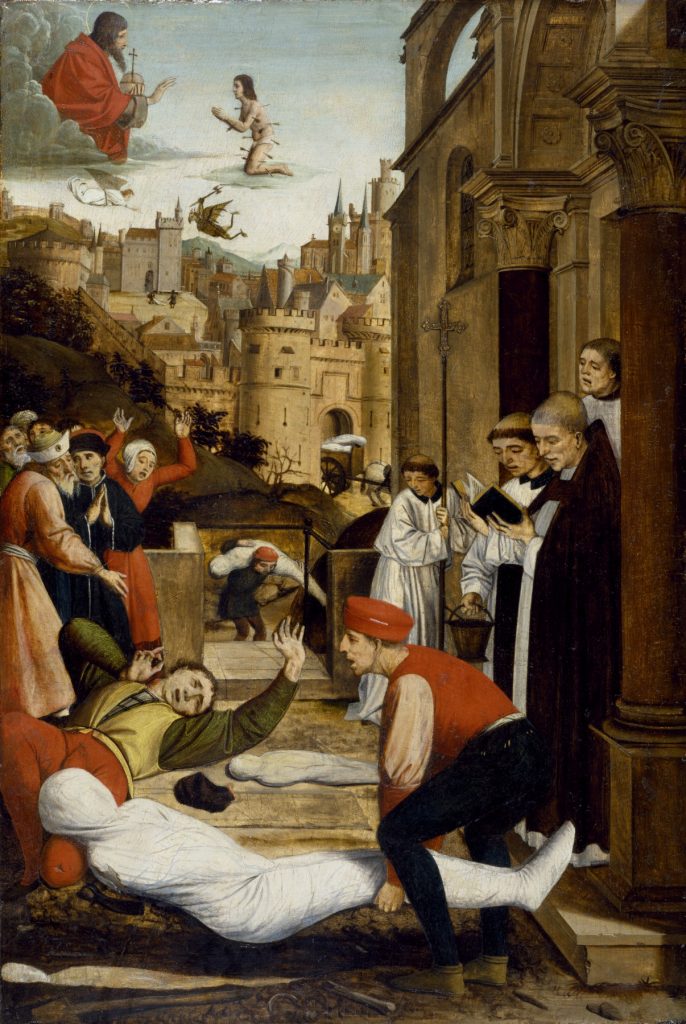There have been many epidemics that have plagued our planet over the last few thousand years; some, however, were more devastating than others. Epidemics often cause major disruptions in a society, besides simply killing people. They affect the amount of people in the workforce, which in turn can disrupt the production of goods and the food supply needed for a society.
The famous Bubonic Plague killed around a third of the population of Europe in the 1300s. The population of Europe in 1340 was about 73.5 million, and the plague affected over 20 million people. Today, Europe’s population is 508,450,856, meaning that if the plague were to have the same effects today as it did in the 1300s, it would kill around 102,000,000 people!1

The Bubonic Plague originated in the fleas carried by rodents like rats, squirrels, and prairie dogs, which transmitted the disease from one to the other. The disease spread from southwestern China to eventually the Black Sea ports of Caffa and Tana by 1346, and by 1348 it had reached northern Europe.2 The disease caused about the same symptoms in all of its victims, such as a fever, and pain so strong that they were not able to keep down any food. The name of this disease came from the fact that the people would become covered in black boils that oozed puss and blood.3 The photograph to the right is an exhibit at the Eyam Museum showing what an infected person would have looked like. The disease was highly contagious and was deadly because it worked so quickly; its victims could have been healthy one day and gone the next.

This image is of a doctor’s mask, which is similar to the masks that doctors used during the plague. These masks were believed to have protected them from breathing in the infected air. However, the masks were not very effective since many doctors contracted the disease.
This epidemic did not affect European countries in just one way, it caused major problems in many aspects of life for many areas. The continent had been battling famine and food shortages before the plague struck; then afterwards it left them in an even more compromising situation. There was a shortage of workers in the workforce, which meant that all aspects of production were affected, from food to goods and services. Try to imagine one third of the people you connect with on a regular basis completely gone. That would be a third of all the doctors, the workers you’ve encountered at the grocery store, a third of all the teachers, and even a third of one’s entire family. While this is happening, one’s entire country might already be going through a devastating famine. It is incredible that Europe was able to recover from this disaster and now has one of the largest populations in the world. The continent was able to recover from losing over a third of its population, in one of the most notorious epidemics in our world’s history, and now thrives as a largely populated and diverse part of the world.
- Josiah C. Russell, The Fontana Economic History of Europe, Vol. I: The Middle Ages, “Population in Europe,” (HarperCollins Distribution Services, 1972); European Union, “Living in the EU,” Europa.eu. (accessed November 2, 2016), http://europa.eu/european-union/about-eu/figures/living_en#tab-1-3. ↵
- Jerry H. Bentley, Herbert F. Ziegler, and Heather E. Streets-Salter, Traditions and Encounters: A Brief Global History Volume 1. 4th ed. Vol. 1. (McGraw Hill Education, 2016), 333-336. ↵
- McClain, Charles. “Of Medicine, Race, and American Law: The Bubonic Plague Outbreak of 1900,” Law & Social Inquiry 13, no. 3 (1988): 447-513. ↵



58 comments
Yadira Chavez
This article is great at explaining the detrimental effects of the bubonic plague, and i especially like the number comparisons that you make to allow people today to understand how horrific it would have been. I can’t imagine losing 1/3 of the people that i know in a short period of time, and i feel so sad for those that might have had to endure it.
Anna Guaderrama
I remember first learning about the bubonic plague back in sixth grade. It never really surprised me as much till later in life when I started reading up more about it and researching it. It’s an interesting moment in history to look into because it shows how advanced we have come since then. It’s crazy to read about how many people died because of the bubonic plague., so thank goodness we have better sanitation and treatments, and overall knowledge over the cause of this.
Timothy ODekirk
The Bubonic Plague is something of a true horror. The Bubonic Plague killed so many people during that time, that an Apocalypse almost occurred from it. With everyone dying from this disease, it is just scary to even think about it. The fact that disturbed me the most was how a person could be healthy one day, and the next day die from the sickness, it was that fast. I just could not get over that. This was an extremely interesting article that was well worth the read.
Kimberly Simmons
Iv’e heard many stories of the plague and its horrendous effects. It is so nasty to think of how a lack of sanitation spread this deadly disease. I had never seen a photo of a doctor’s mask before, so that was interesting — it’s funny looking. Thank goodness we have better sanitation and treatment methods nowadays so that this type of outbreak is significantly less likely to happen.
Belia Camarena
The amount of people that the bubonic plague killed is astounding! Over one third of the population in Europe died and almost everyone was at least indirectly affected. Before reading this article, I knew that the plague was bad, but I had no idea the extent of its damage. I cannot imagine how difficult it was for these European cities to recover, and for people to return to their daily activities after the plague calmed down.
Samuel Ruiz
This was a great article, Angelica, especially with the opening hook of “epidemics that have plagued our planet” and its tie to the topic of the article. It is interesting to imagine just how much of the population was affected by the plague, in comparison to the current population of Europe. The explanation of the affects on any person by the disease had me surprised. It is scary to think about the fact that a person could have been perfectly healthy one day, and died the next. I like that you had the audience relate the affects of this plague to their own lives, which gives a personal idea of just how bad the country had it at the time.
Vanessa Tombo
Prior to reading this article, I had a very rudimentary understanding of how many lives were lost as well as how the bubonic plague manifested in Europe and eventually throughout the world. The author’s use of number helped me gain a better understanding how lives were lost to a horrid disease. With the use of images, I was also able to gain a better understanding of how medicine has vastly advanced.
Tyler Sleeter
Great article with lots of information. The plague is one of those things in history that is sometimes hard to understand. It had to be hard to live at that time, not knowing how disease was spread, or even how to prevent it from spreading, and watching the people you know go from healthy to dead in a matter of days. I had read somewhere that it was common for the wealthy residents of London to move out to the country while the plague happened and that most of them survived. I also remember one of my biology teacher’s explaining that the many of the people that survived the plague must have had a natural immunity to the disease that they passed down to through genetics and that is one reason why the plague is rarely seen in modern times.
Oceane Roux
Thank you for this article! The knowledge that I had on the bubonic plague were pretty superficial before reading this article, and the author did a good job gathering information on the topic. It is crazy how so many people in Europe have died from the disease. The article is extremely descriptive, and the images, while very disturbing, add a lot to it.
Belene Cuellar
It’s scary to think that one day a person can be completely healthy and then the next day they drop dead oozing blood. So many families destroyed by the plague, and the economy suffering because the number of workers were dropping by the minute. This article did a good job in capturing the severity of this epidemic, the images were so helpful and informative to me. I still can’t believe that so many doctors went out of their way to try and help even though they were still at high risk of coming in contact with the plague.